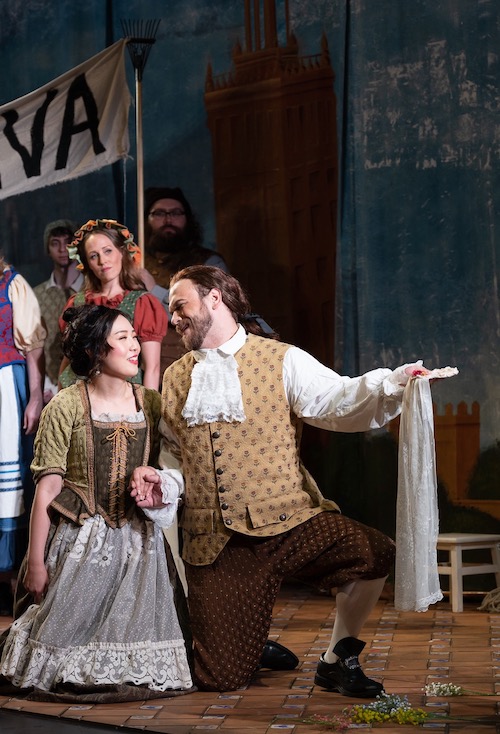Maryland Lyric Opera returns to the stage with an outstanding “Figaro”

Javier Arrey and Mary Feminear as the Count and Countess in Mozart’s Le nozze di Figaro at Maryland Lyric Opera. Photo: Julian Thomas
After two semi-staged concert performances earlier this spring, Maryland Lyric Opera closed out its season in the Kay Theatre at The Clarice. For the first time since Massenet’s Thaïs, just before the coronavirus lockdowns in 2020, the company put a complete opera on the stage. This commendable new production of Mozart’s Le nozze di Figaro, delayed two years by the pandemic, opened on Wednesday night.
Bass-baritone Hunter Enoch headlined a strong cast of mostly MdLO regulars, with a polished performance as Figaro. His interpretation was vocally agile, displaying consummate control over the entirety of the role’s range, including powerful top notes. As the servant who ultimately outwits his bullying master, Enoch’s calm presence seethed with repressed resentment.
Nayoung Ban’s Susanna counterbalanced Enoch with her lighter soprano, a sunny, more humorous presence against Figaro’s anger. Ban’s voice sparkled most effectively in a show-stopping “Deh, vieni” in Act IV, down to some rich low notes, although she sometimes lacked the potency to shine at the top of the ensembles.
The couple’s noble counterparts made brilliant foils to the servants, beginning with the blustering, arrogant Count of baritone Javier Arrey. Deploying a superbly refined voice, he incarnated the aristocrat’s surface polish and internal rage, as his plans and desires were continually thwarted. The sincerity of his repentance at the end of Act IV, in glowing legato sound as he knelt before his wronged wife, movingly rounded out a laudable performance.
Soprano Mary Feminear made an exquisitely beautiful Countess, equal in lyric beauty to her husband and much more sympathetic in her tragic sadness. Her two demanding arias proved high points of the evening, the tone limpid with an even vibrato in Act II’s “Porgi, amor.” Her ultra-soft repeat of the main theme in “Dove sono” added a forlorn note to the neglected wife’s lament, and she melded beautifully with Ban in the Act III Letter Duet.
Among the supporting cast, top praise goes to the astonishing mezzo-soprano Allegra De Vita, who has shown incredible range in her acting abilities over the years at Washington National Opera and other local stages. Her masculine way of standing and walking convinced visually as Cherubino, and her unparalleled vocal command of the character’s two arias sealed an interpretation of the hormonal teenager that was appropriately more awkward than antic.
The Washington-born bass-baritone Kenneth Kellogg, a menacing Grand Inquisitor in the company’s Don Carlo, showed his equally fine humorous side as a ridiculous, pompous Bartolo. Mezzo-soprano Leah Heater made a striking company debut as an over-the-top Marcellina, a potent voice that served her comic aims and made its presence known in ensembles. (Her aria and the one for Basilio were, as usual, cut from the fourth act.)

Nayoung Ban as Susanna and Hunter Enoch as Figaro in Mozart’s Le nozze di Figaro. Photo: Julian Thomas
Tenor Joseph Michael Brent built on his success as Pang in the company’s Turandot earlier this year, with fine comic timing and a burnished tone as Basilio. Melissa Mino made a flirtatious, fluttery Barbarina, and Michael Pitocchi gave vocal weight and oafishness to the gardener Antonio. Mauricio Miranda showed comic appeal as the lawyer Curzio, but his rushing of the beat helped to destabilize the Sextet in Act III. The small chorus, prepared by associate conductor Husan Park, added rustic verve to their scenes.
Music director Louis Salemno elicited a laudable and unified sound from his compact orchestra in the pit. The strings, winds, and horns all responded with athletic grace in the overture, and the woodwinds consistently excelled, especially on their beautiful lines in Susanna’s “Deh, vieni.” Singers strayed from the beat on more than one occasion, more so than the orchestra, indicating that Salemno’s gestures were not always clear to the platform. Husan Park accompanied the recitatives from a harpsichord in a balcony near the stage.
David Gately directed the staging, originally conceived for the company in collaboration with the great bass-baritone Ruggero Raimondi. The production hewed to the opera’s intended setting and time, in keeping with MdLO’s aims of presenting “classical” or traditional productions. Clever acting direction often enhanced characterization, as when Cherubino first embraced Susanna, putting his hand firmly on her breast. Handsome costumes, designed by Glenn Avery Breed and rented from Wardrobe Witchery, clarified the 18th-century social distinctions between characters.
Carmen Castañon’s scenic design consisted of four painted backdrops, hung one in front of the other. With each new act, one was removed to reveal the next, gradually enlarging the stage space from the claustrophobic environs of Figaro’s bedroom in Act I to an expansive, moonlit garden in Act IV. Lighting designed by Jeff Bruckerhoff added considerably to the visual appeal of the latter. The scene changes required intermissions after Acts I and II, lengthening the run time to almost four hours.
Le Nozze di Figaro runs through July 3. mdlo.org
